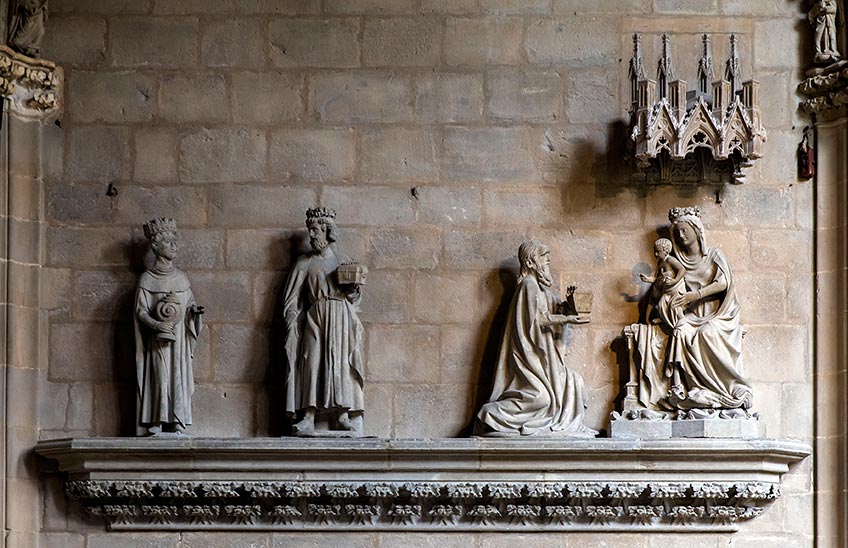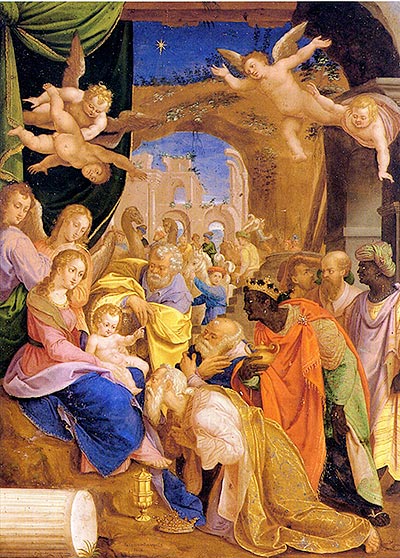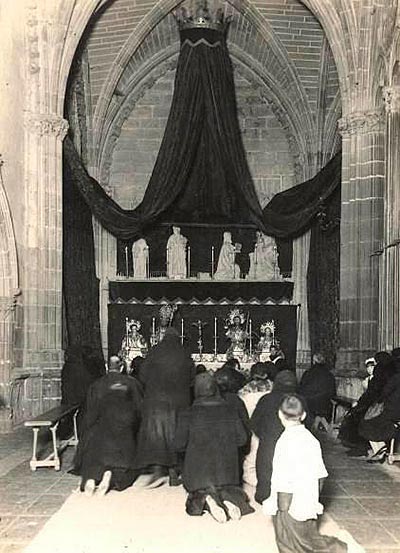The Feast of the Epiphany in Pamplona Cathedral

FotoCedida/group of the Epiphany in the cloister of Pamplona Cathedral by Jacques Perut, beginning of the 14th century.
The solemnity of this day was magnified in Pamplona Cathedral, since the Middle Ages average, by the presence of a Gothic sculptural group in the cloister and the relics of the Three Wise Men, kept in a silver reliquary from the last quarter of the 16th century.
The liturgical texts of the time of Bishop Arnalt de Barbazán, both the Breviary of 1332 and the oldest liturgical guide of the diocese, include the feast of the Epiphany among those of the second category, specifically among those called "Principal", with a solemn rite, among which are also Ascension, Trinity, Corpus Christi, Saint John the Baptist, Purification, Annunciation, Dedication of the Cathedral, Saint Peter and Paul, Crown of Christ, Saint James, Saint Augustine, Nativity of the Virgin, Saint Michael, Saint Fermin, All Saints and Saint Martin. The Epiphany was therefore at an intermediate stage between the so-called "most excellent" (Christmas, Pentecost, Easter and the Assumption of the Virgin) and the "magnas", which were below them.
Relics, festivities and the sculptural group , carved around 1300 by Jacques Perut in the cloister, made up a unique celebration of which some of its ancient rites are still preserved, especially in the cloister procession with its statio before the Magi and the solemn proclamation of the annual feasts.
The importance of the choir in the centre of the nave, as the pre-eminent place for worship and the reception of the bishop, was emphasised throughout the ceremonial. The significance of the choir is intimately linked to cathedrals and they can only be understood and valued in the space in which they were conceived, as Pedro Navascués recalls "in the same way that the cathedral, as a space and architecture, can only be understood by developing its functions around the choir". The presence of the choir in the nave is what gave Spanish cathedrals their own personality within the European panorama, constituting one of the most extraordinary facets of Spanish cultural heritage. Liturgy, music, cantorales, processions, burials, ceremonial, organs and instruments are inherent to these great ensembles.

Painting of the Epiphany from the chapterhouse of Pamplona Cathedral conference room signed by Jacobus di Marsella, late 16th century.
Seasonal procession through the cloisters
In the list of festivities of the 18th century, written by the prior Don Fermín de Lubián, we are informed that on the Vespers of the Epiphany, on the afternoon of the 5th, the musical instruments were incorporated into the organ, with the performance of Christmas carols planned. It is also stated that if it was Saturday, the Salve would be sung with harp accompaniment.
Handwritten memoirs from three hundred years ago already record the celebration of a procession through the cloisters with two stations, the first under the sculptural group of the Kings and the second by the door of the refectory. The bishop was in charge of the sermon at the main mass of the feast, and the carols took on a special role, as on the great festivities.

Epiphany celebration in the cathedral in a photograph by Julio Cía, 6 January 1933. file Municipal Pamplona
Some other documents written by the temple's masters of ceremonies provide us with some more specific information at data . Thus, around 1820, Don Bernardo Astrain, a prolific writer, gives an account of the use of shawms in the procession, adding some rules for venias, salutes and protocol, in the case of the bishop and the viceroy being present.
Further details are provided by a curious ceremonial manuscript from the second half of the 19th century. The hora de Tercia, which preceded the mass, was sung with great solemnity on that day, with special tuning and tranquillity, alternating instrumental music with the choir and organ in the interludes. The procession had the following route: "It goes along the fence, leaving it between the main chapel and the pulpit of the Epistle in the direction of the cloisters. It goes around the cloisters from left to right, making the two customary stations, at the portable altar that is placed under the effigies of the Holy Kings and next to the door of the Archdeaconry...., and passing back into the church, it enters through the fence in the same place as it left, with the presbytery and ministers of the chapter taking their leave at the door of the presbytery more solito and all the rest being done as on the day of the Circumcision".
In the first station, the infants participated with a verse answered by the chapel with figle accompaniment. The second station was held at the door of the archdeaconry, with a similar outline .
Under the Gothic Epiphany group , there was an altar with a backdrop upholstered in rich red damask, which was crowned with a canopy, simulating a chapel. On the pedestal of the sculptural group were placed candelabra and several vases with bouquets. In the lower area, the altar with the relic of the Magi in the centre and the four silver busts of the co-patrons Saint Fermin and Saint Francis Xavier, Saint Ursula and Saint Mary Magdalene were placed, as they are today. Until 1879, the sculpture of the Infant Jesus, brought from the Dominican convent, was placed there.
Throughout the day, the relic of the Three Wise Men was left there for public adoration, and the main sacristan, assisted by another priest, took care of the order. Benches were placed in front of the altar for this purpose.

Altar with the reliquary busts on the day of the Epiphany in the cathedral, 2019. Photo M. Bretos
Tumulus at report of the kings of Navarre
The oldest records give an account of another singularity of the festival in the Pamplona church, which consisted of the placing in the main chapel of a tomb or tumulus at report of the kings, which remained there throughout the octave. It was a small catafalque covered by a cloth that the chronicles call "the royal mantle", which we do not know if we should identify with a "rich red cloth of silk and velvet", used for the same purpose during the second half of the 19th century.
One of the nineteenth-century manuscripts gives a detailed account of that custom, as follows: "According to the old internship of this church, a kind of tomb covered with a dark red velvet cloth is placed at the level of the chancel, whose head or end nearest the altar rests on the first tier of the replan. This tomb is there from the first Vespers of the Epiphany until the end of the octave of the feast. The origin of the aforementioned tomb seems to be, according to what my colleague Don Fermín Ruiz Galareta explained to me, who was the beneficiary psalmist of this Holy Church and a person very knowledgeable about the antiquities and practices of the same, that there used to be a mausoleum or sepulchre of Kings in the presbytery, and in order, no doubt, to make that place more accessible, they agreed to remove it from there and to place this tomb during the octave of the Epiphany, as well as on the day of the Faithful Departed. The stone or tombstone that covered that sepulchre is, according to Mr. Galarreta, the one that today is embedded above the door of the upper cloister".
The informant mentioned, Don Fermín Ruiz de Galarreta Lavilla appears as maitinante in 1836 and as chaplain in 1839. In 1855 he was invited to accept the first sochantry, which he did. His transcript retirement, after forty years of service, is dated 1879. He died in 1882, being replaced by Urbano Ros.
The tomb in question is none other than the lid of a sepulchre recessed above the door of the cloister, which has been identified as belonging to Doña Blanca, daughter of Carlos III and deceased in Olite in 1376, or to the princess Doña Magdalena, mother and guardian of Francisco Febo, a hypothesis put forward by Arigita. Stylistically, Martínez de Aguirre relates the work to the French sculpture of the Reims orbit and the production of Jean de Liège.
Beyond the identification of the royal personage in the tomb and whether this is the one that today is found in the doorway of the cloister, what is really important is the confirmation that in the main chapel there was at least one stone tomb of the royal house of Navarre, which opens up avenues and hypotheses in relation to the monarchy and the first diocesan temple.
In 1899 the chapter agreed not to continue with that secular internship , with the angry protest of the canon and historian Mariano Arigita, who wrote: "I complained in the name of history, but I was ignored".

Cloister procession on Epiphany Day in the cathedral, 2020. Photo A. Calleja. Newspaper of Navarre
To find out more
ARANDA RUIZ, A., "Reges Tharsis et insulae munera offerent. Una escena de Epifanía en la catedral de Pamplona", Pieza del mes de diciembre de 2020, Chair de Patrimonio y Arte Navarro. . enquiry December 15, 2021.
FERNÁNDEZ GRACIA, R., Navidad en la catedral de Pamplona. Ritos, fiesta y arte, Pamplona, department de Historia del Arte. University of Navarra, 2007
